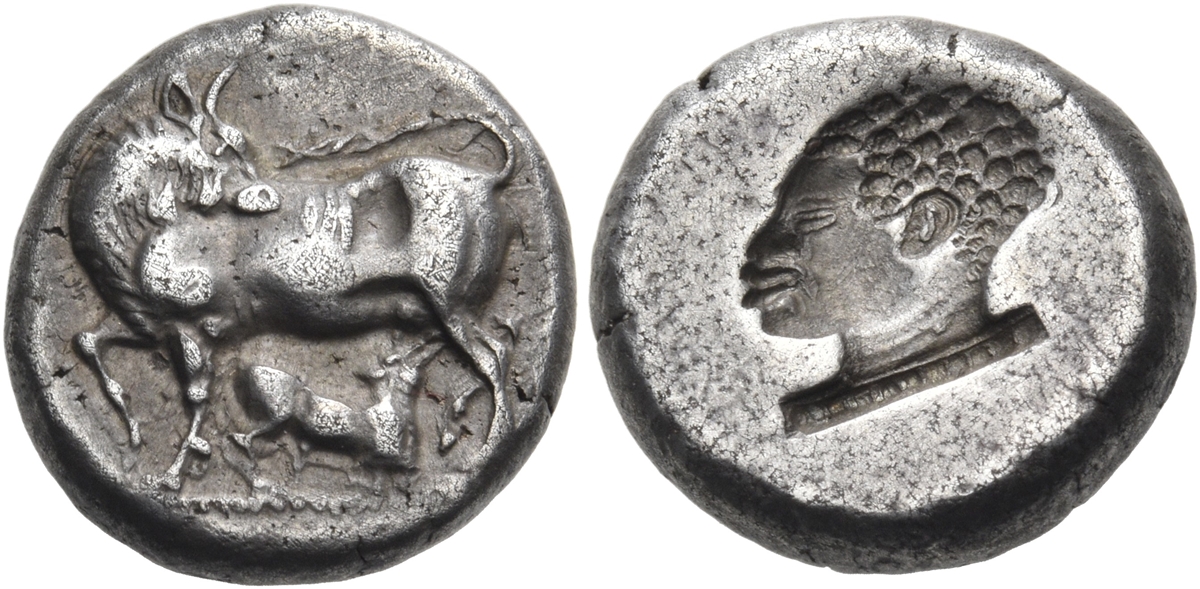Second known example
Lot 159

NORTHWEST ASIA MINOR. Uncertain mint. Circa 475-450 BC. Hemistater (Silver, 16.5 mm, 5.99 g, 2 h). Cow standing to left on a dotted groundline, her head turned back to right, her right fore- and hind-hooves raised, and her tail flicking over her back, with, below her, a suckling calf kneeling to right. Rev. Head of a youthful male African, perhaps a Nubian, with prominent lips, kinky hair and a dotted neck truncation. See Gemini IV, 2008, 195 (same dies), for the first known example of this type, otherwise unpublished. Of great rarity, apparently by far the best of four known examples. Well-centered and both enigmatic and attractive. Extremely fine.
From a Swiss collection, ex Numismatica Ars Classica 52, 7 October 2009, 177.
This is quite an extraordinary coin: not only does it bear one of the few heads of a clearly sub-Saharan African ever to appear on a Greek coin, its mint is also subject to debate. The first known example of this type was termed a 'hemistater' and tentatively attributed to a mint in Caria, simply because it appeared with an equally unknown didrachm that was slightly more reasonably attributed to Samos (despite the fact that it really does not look Carian and both the reverse type and the reverse technique is unknown there). When this specimen appeared its cataloguer pointed out that while the cow and calf did appear on coins from central and northern Greece, as well as Asia Minor, the Negro head only turned up in Asia Minor. Nevertheless no firm, or even wobbly, attempt was made to localise the coin's mint. Recently, it has been suggested that this coin may have been issued at an uncertain mint in northern Greece, using the extensive 'cow and calf' coinage of the Bottiaei as a parallel (SNG ANS 923-925 and Svoronos Hell. Prim. pl. XVIII passim): this is highly unconvincing since all the cows that appear there have straight legs, not bent ones. A far better clue is the extraordinary fact that the Negro head on the reverse is incuse. First, of course, the head of a Negro (usually male but sometimes female) is only known from a very small number of Greek mints: a) on billon 1/12th staters from an uncertain mint on Lesbos; b) on rare electrum from Kyzikos; c) as a symbol on a stater from Teos in Ionia; d) on hektai from Phokaia; e) possibly on silver of the Lycian dynast Uvug - a female figure who may not be of any definable origin; f) on early silver from Massalia; g) on extremely rare early silver fractions from Athens; h) on very rare silver from Delphi; i) on a tritetartemorin from a mint in Arkadia; and j), possibly, but not probably, on a silver piece from Kyrene (the famous bronze of the Hannibalic period from Arretium is irrelevant here). What is clear is that there is a concentration in the area of Mysia, Lesbos and Ionia; but even more important is the curious incuse technique of the result: this is basically only paralleled by the early electrum coinage of Mytilene (the incuse types from Etruria and Phoenicia are completely different). The idea that the same technique would be used by a mint far distant from the island of Lesbos seems, therefore, massively unlikely. But what mint that was...?
Current Status
Online bidding closes: 22 May 2022, 09:00:00 CEST Current Date & Time: 26 Apr 2024, 05:06:27 CEST Remaining Time: Closed Hammer Price:70000 CHFPre-Bidding closes on 22 Mai 2022 at 9:00 CEST. Live bidding starts at 14:00 CET and is EXCLUSIVELY available on biddr. Separate registration is required.
